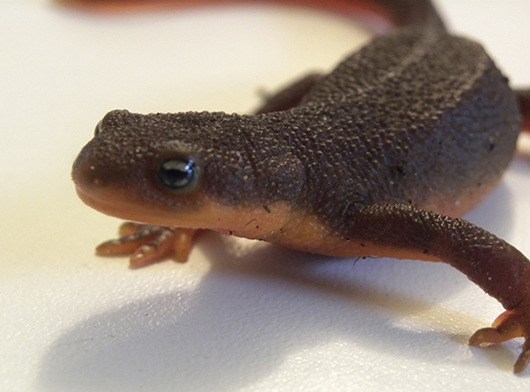by SHONA AITKEN
Wolf Hollow Wildlife Rehabilitation Center
We counted eight of the little animals – dead and squished flat by cars – on just one short stretch of road. We also found two others, slowly making their way across the road, so we carefully scooped them up and moved them into the long grass at the side of the road. Most people driving along would never have noticed these tiny creatures, only three to four inches long. The little creatures were rough-skinned newts.
At this time of year the females are moving from the woodland where they spend the winter, to their breeding ponds and wetlands. Sadly their route often takes them across roads where many are killed by cars. These little newts are quite abundant on the islands, but most people have never seen one, because they are so small (a really big one is about six inches long) and they spend most of their time hidden in vegetation on the forest floor or in ponds and wetlands. They look a bit like lizards, with long bodies and long tapering tails, but they are actually amphibians, with moist skin.
Their top side is covered in small bumps (hence the name “rough-skinned”), and can be a range of shades of brown, but their belly is bright orange or sometimes yellow. Several years ago we were driving on Orcas and came across a newt slowly crossing the road.
Of course I had to rescue it so it wouldn’t get run over. When I approached, it curled its front end up in an exaggerated push-up, flashing its bright orange underside at me. That is newt-speak for, “try to eat me and you will die!” This is no empty threat, as the newt’s skin produces a potent neurotoxin that will kill most predators if they eat one. The exception is the common garter snake that seems to be immune to the toxin and regularly has newt for breakfast. I had no intention of eating the newt and knew I wouldn’t die from briefly touching it, so I ignored its warning, gently scooped it up and moved it off the road.
And then I washed my hands. For the next few weeks, and again in fall when they return to the woodland for the winter, rough-skinned newts will be on the move and will be vulnerable when they have to cross roads, so look out for these little creatures when you are driving, and let friends and neighbors know too.
If you know of an area where newts are breeding or crossing roads, we’d love to know.
Give us a call 360-378-5000 or send an email to wolfhollow@wolfhollowwildlife.org.



